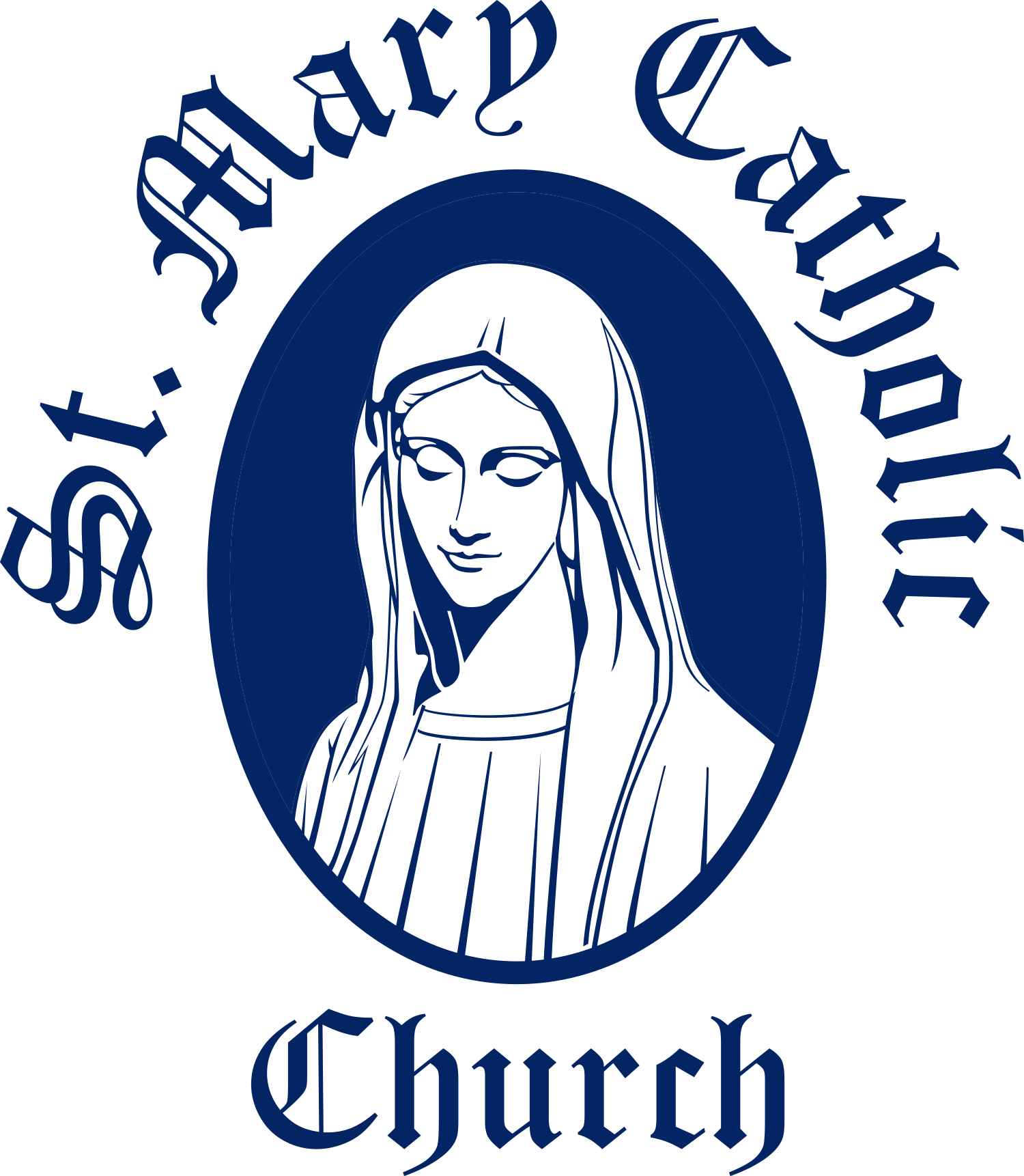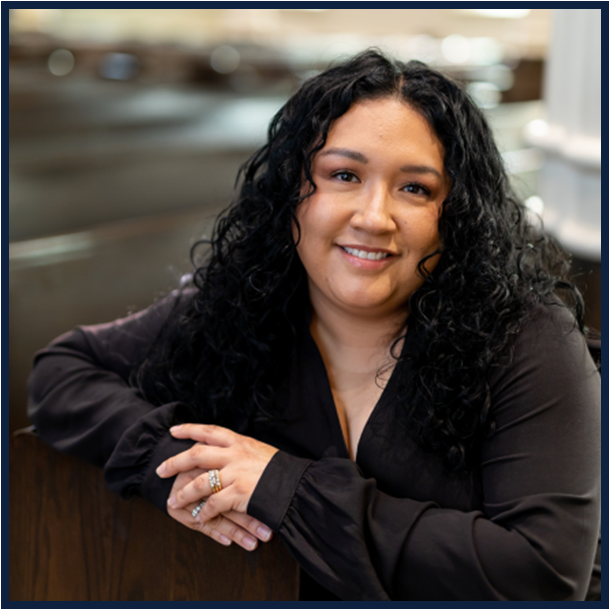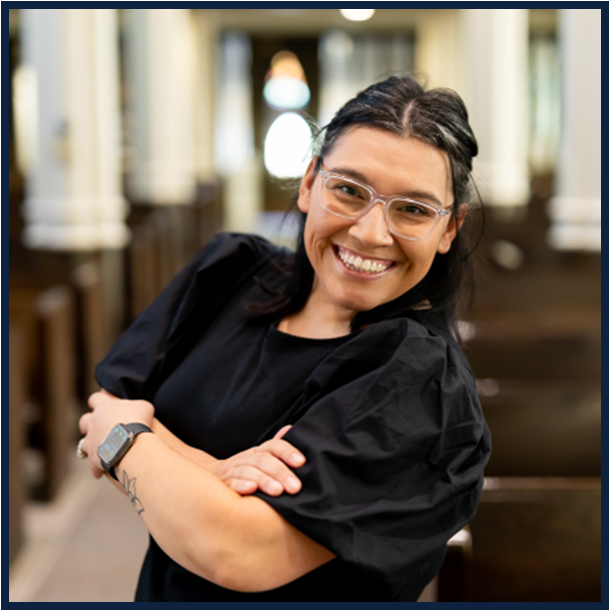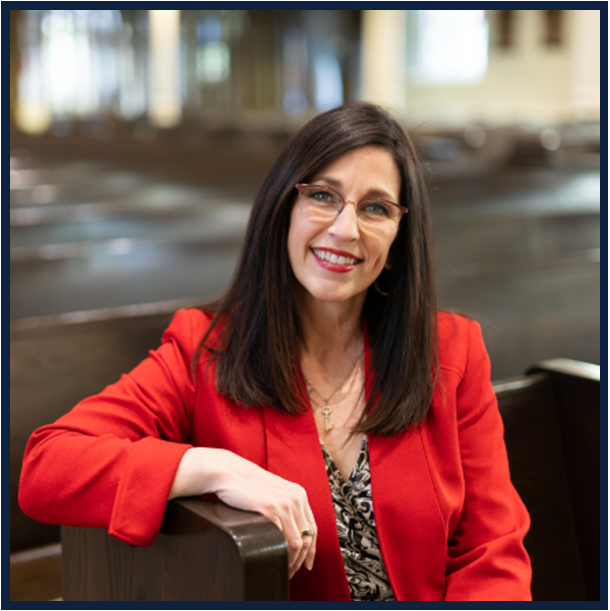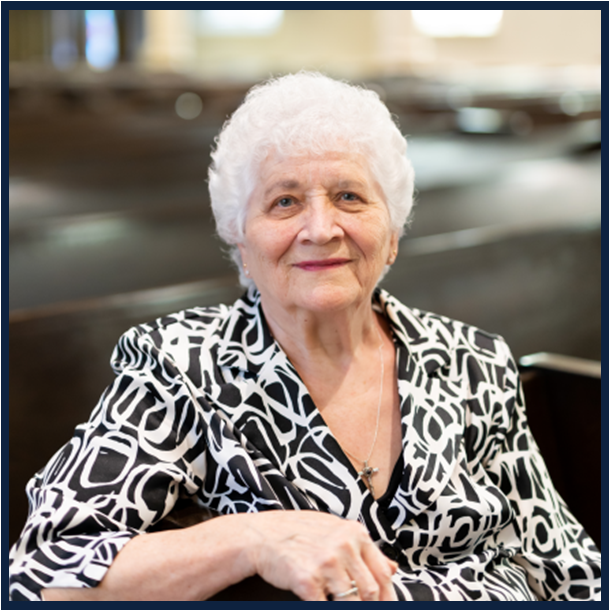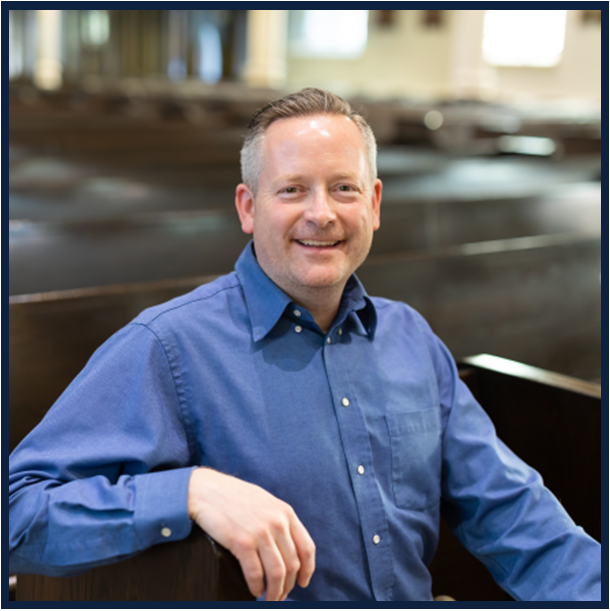Narrative Vision Statement
At St. Mary’s, our Mission is to worship, serve, and build communion in Jesus Christ, with Mary our mother and guide. We have a Vision of our Parish that characterizes our desired future if we live up to our Mission.
Our Vision for worshiping Jesus Christ includes praying together as a parish, learning about our Faith, celebrating with wonderful music, and receiving our Sacraments within a beautiful church.
Our Vision for serving Jesus Christ includes many ministries that allow parishioners to serve our Lord and to serve the parish. It also means that we proactively serve one another to support and assist each other with the needs we may have. Finally, serving also entails having a community presence that is unique to the downtown Lincoln area.
Our Vision of building communion with Jesus Christ focuses on our communion with one another as people of faith. We strive to create a welcoming atmosphere and we make an effort to form bonds with one another as adults and among our youth by choosing to spend time with one another via parish events, as well as by creating opportunities to engage with each other outside of church. When we invite the Holy Spirit to be among us as a group of Catholics, we are strengthened in our faith and in our communion with Jesus Christ and with each other.
We actively seek the assistance and guidance of our Blessed Mother Mary as we endeavor to make her Son, Jesus, the center of our parish and of our lives. And all that we endeavor to do, we do it with the guidance and help of the Holy Spirit—in this way we aspire to holiness.
We live our Mission in the above ways by being proactive stewards of our parish. It is our Vision, then, to provide leadership and governance that effectively manages the activities of our parish. We also envision a future facility that will provide space to support our ministries, activities and needs. It is our vision that we become a parish that understands and takes into consideration how we may be of value to one another economically. We aim to be empowered in our efforts because we know that the future of the parish depends upon our willingness to become engaged and to provide leadership to pursue our Vision. To that end we will volunteer and we will effectively manage our volunteer efforts. And finally, we will sustain our facilities such that they remain a beautiful home for all that we envision.
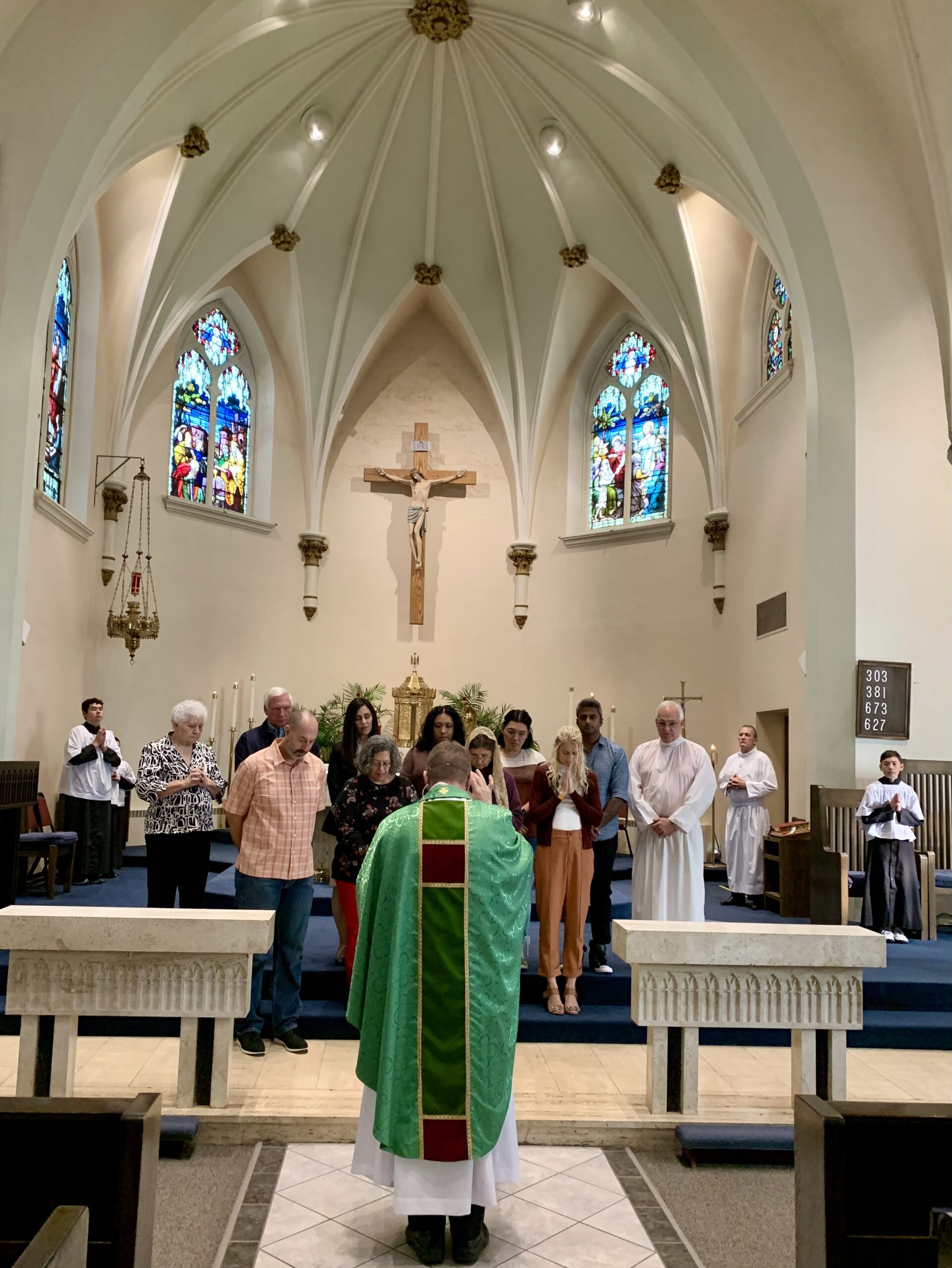
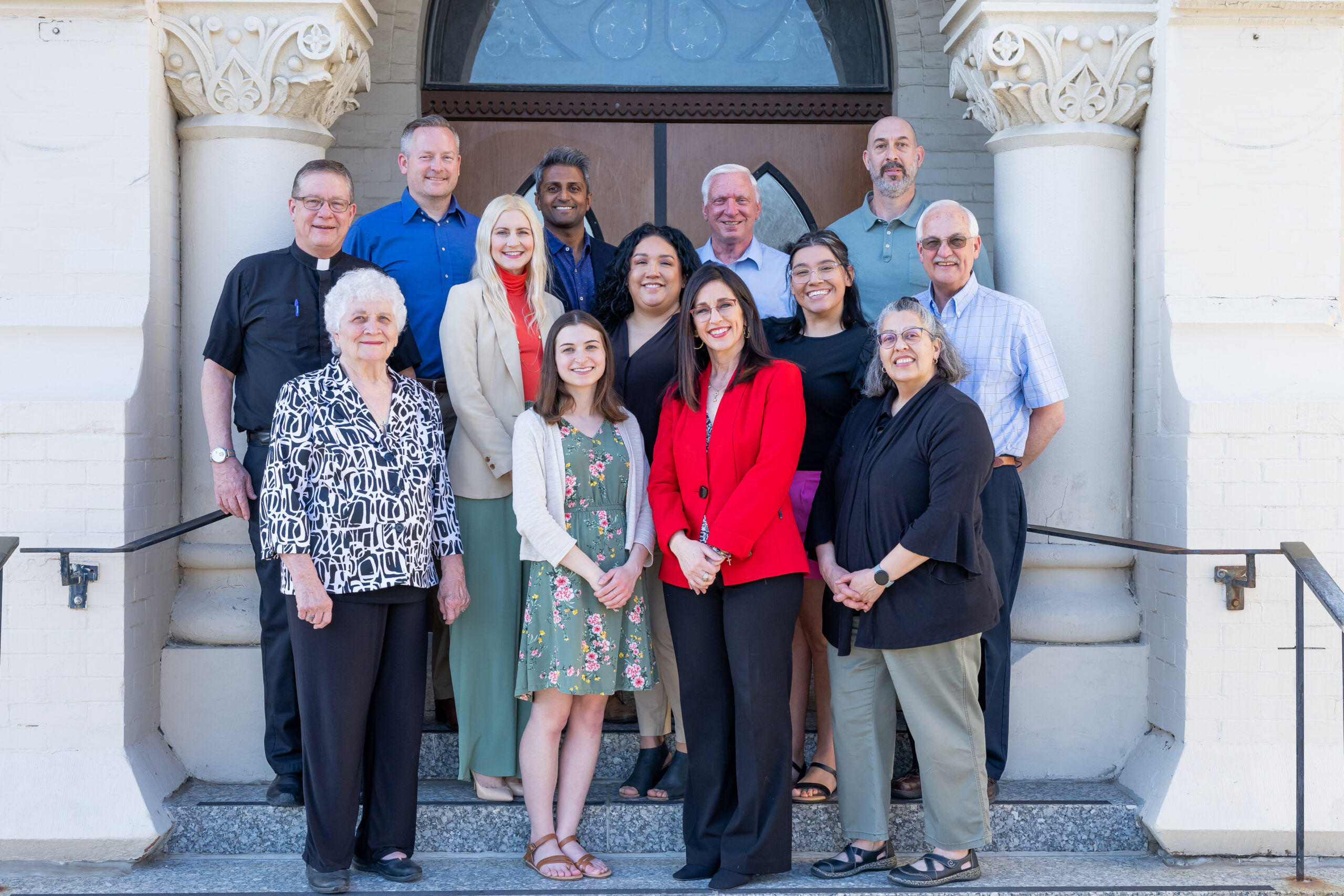
Vision Model
The purpose of a model is to visually depict the Vision such that all of the ideas and priorities for which there is consensus are represented in relation to one another. The Model on the following page illustrates the Vision in this way.
Below the Model is a narrative explanation as to what the Model means. There are many ways to depict the Vision, and the Model on the following page is just one way. The purpose of depicting the Vision in model form is because 1) Many adults are visual learners; 2) The illustration provides a common basis for discussion; 3) The parts of the Model can be moved around easily as different questions are asked and new insights are shared; 4) A model helps highlight important priorities and themes; and, 5) A model helps a group of people stay focused on what they’ve decided.
A model of a Vision is both common and unique at the same time. It is common in that Vision Models usually depict similar types of content, and the parish might wonder how is this Model unique to St. Mary’s? The uniqueness shows up in the words: the Mission, the titles of boxes, etc. It’s similar to using a template for a business plan that one might find on the internet which is populated with custom information. The further uniqueness about the Model on the following page that makes it relevant to only St. Mary’s Catholic Church in Lincoln, Nebraska is 1) It showcases what the people of the parish have discerned; and 2) It represents the current culture and the desired culture of the parish. This is your Model, no doubt, and the task with this draft is to shape it to what you want it to be. When it’s all said and done, a parishioner should be able to hold up the Vision Model and say “This is where we’re going and what we’re doing, and I can explain what it means and how this Model helps us stay on track to reach our Vision.”
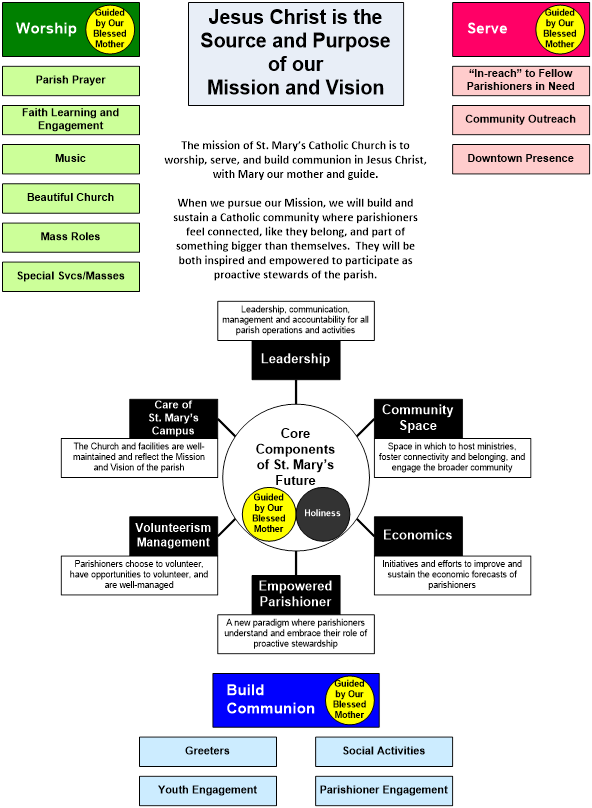
Narrative Explanation of the Vision Model
The following pages explain each Component of the Vision Model, as well as identifies the Chairperson of each Component. Many ministries exist (e.g., Legion of Mary, Knights of Columbus, Acolytes, Altar Society, etc.) and they will continue to perform their roles and contribute to the internal and external communities in the various forms of service they offer.
Jesus Christ is the Source and Purpose of our Mission and Vision. |
The mission of St. Mary’s Catholic Church is to worship, serve, and build communion in Jesus Christ, with Mary our mother and guide.
When we pursue our Mission, we will build and sustain a Catholic community where parishioners feel connected, like they belong, and part of something bigger than themselves. They will be both inspired and empowered to participate as proactive stewards of the parish.
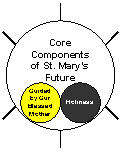
Core Components of St. Mary’s Future: The wheel at the center represents the human core of the organization. The parish is, after all, a form of organization. If the parish cannot run itself well then it will fail, and more importantly it would not be able to live its Mission and support the three elements of Mission. The pastor and parishioners in collaboration must provide strategic leadership (Mission and Vision) as well as operational and programmatic leadership to ensure that the parish thrives as a community within which the Sacraments are offered and received. When effective stewardship of the organization is achieved, the parish has the best opportunity to achieve its goal of connectedness and vibrancy. Jesus Christ is at the top of the Model and therefore fully present within this wheel, as is our Blessed Mother. The conscious effort, too, to invite the Holy Spirit to always be present and to strive for holiness in all that we do is represented. Finally, each spoke is a critical component that needs effective stewardship.
Effective stewardship goes beyond time, talent and treasure. It means that parishioners have broken free of the traditional paradigm in which they are un-empowered and waiting for the pastor to decide and do everything. The pastor does not lose his authority in this Model, but rather expects parishioners to step up and step forward to help build the parish into what it could and needs to be based on their collective needs.
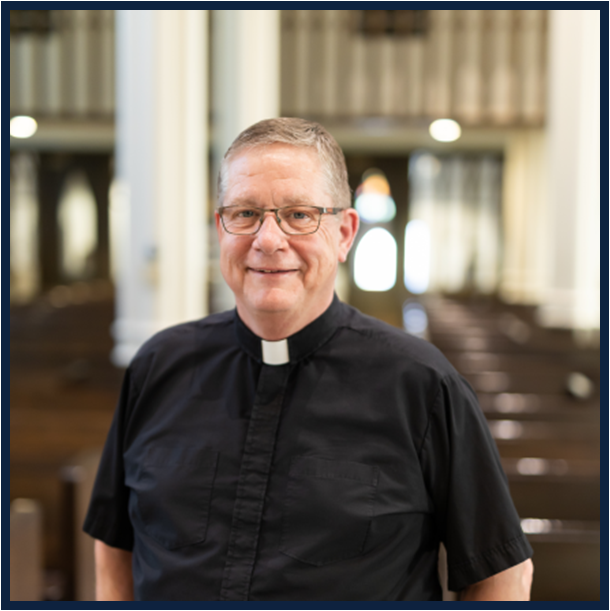

Core Components of St. Mary’s Future: The wheel at the center represents the human core of the organization. The parish is, after all, a form of organization. If the parish cannot run itself well then it will fail, and more importantly it would not be able to live its Mission and support the three elements of Mission. The pastor and parishioners in collaboration must provide strategic leadership (Mission and Vision) as well as operational and programmatic leadership to ensure that the parish thrives as a community within which the Sacraments are offered and received. When effective stewardship of the organization is achieved, the parish has the best opportunity to achieve its goal of connectedness and vibrancy. Jesus Christ is at the top of the Model and therefore fully present within this wheel, as is our Blessed Mother. The conscious effort, too, to invite the Holy Spirit to always be present and to strive for holiness in all that we do is represented. Finally, each spoke is a critical component that needs effective stewardship.
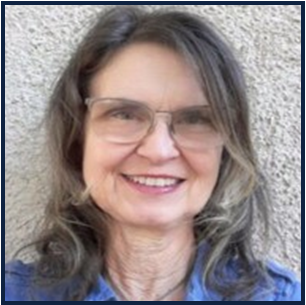
Sue Kouma Johnson
Blessed Mother Chair
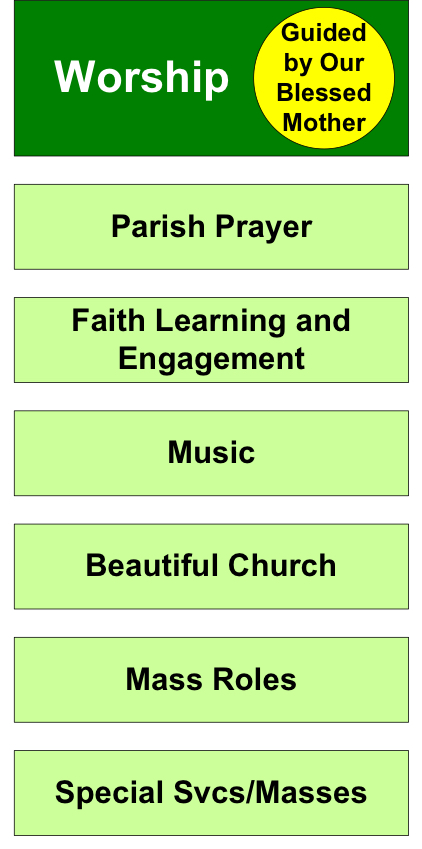
This Chairperson role is open! Please contact [email protected] if you’re interested.
This component is the “Worship” component. The essence of this word, remember, is to ensure that our worship of Jesus Christ is worthy of Him. Some of the priorities that surfaced during this planning process are listed in the boxes below the main box. The color green does not mean anything and can be changed to whatever color the Planning Team prefers.
Each box can be broken down into more detail, and some starter suggestions are as follows (again, based on input gathered thus far):
Parish Prayer: includes the Rosary before Mass; special prayers and prayer times to celebrate our Blessed Mother; organized encouragement for families to pray at home, particularly the Rosary, but other prayers as well; instruction as to how to pray effectively; etc.
Faith Learning and Engagement: includes programs such as RCIA; Bible studies; guest speakers; CCD; and other forms of formal learning about our faith.
Music: includes the Music Ministry; the organ; choosing music for Mass and how that gets accomplished; possibly hiring a Director of Liturgical Music; special concerts; styles of music, etc.
Beautiful Church: includes refurbishment; possibly adding new statues; new space to glorify our Blessed Mother; other enhancements, etc.
Mass Roles: includes all roles necessary to deliver a beautiful Mass, from Acolyte to Altar Server and everyone in-between.
Special Services/Masses: includes weddings, baptisms, funerals, etc.
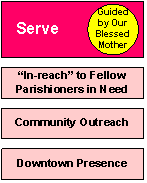
This Chairperson role is open! Please contact [email protected] if you’re interested.
This component is the “Serve” component. The essence of this word, remember, is to be Christ-in-the-moment to others, thus serving Jesus Christ. Some of the priorities that surfaced during this planning process are listed in the boxes below the main box. The color red/rose does not mean anything and can be changed to whatever color the Planning Team prefers.
Each box can be broken down into more detail, and some starter suggestions are as follows (again, based on input gathered thus far):
“In-reach” to Fellow Parishioners in Need: includes all of the many possible ways that the parish can begin to assist, support and help those who expressed some sort of need within the health and wellness section of the survey. The phrase “in-reach” is important because it complements the traditional “outreach” that Catholics like to perform, and it draws attention to the fact that our very own parishioners need help, too. What exactly will be done or offered? That’s a question requiring further discussion and discernment, but there is definitely a need for it.
Community Outreach: includes FoodNet; other services to those in need, or at least a process for connecting people with other available services (such as Catholic Social Services); other forms of outreach that typically address a need in the immediate community. We also need to define specific communities that would be good to target and foster, such as a government community, entertainment/hospitality, young professionals, or businesses and business leaders—what could it mean to engage targeted communities? Additionally, many existing ministries will continue to contribute their efforts at community outreach.
Downtown Presence: includes opportunities to leverage the location across from the Capitol (e.g., Right to Life); participating in community events from the “front porch” of the church; signage; possible new space that the community could utilizes (e.g., wedding reception space, or meeting rooms within a new building in place of the old school); creating some sort of safe haven space in the midst of the downtown hustle and bustle; and other opportunities to have an impact.

This component is the “Build Communion” component. The essence of this word, remember, is to form a community to which parishioners feel like they belong, and have solidarity in their love of Jesus Christ. Some of the priorities that surfaced during this planning process are listed in the boxes below the main box. The color blue does not mean anything and can be changed to whatever color the Planning Team prefers.
Each box can be broken down into more detail, and some starter suggestions are as follows (again, based on input gathered thus far):
Greeters: specifically means people at Mass greeting those who arrive, and saying goodbye when they leave; it could also be interpreted more broadly in the sense of trying to instill a welcoming spirit within all activities and facets of the parish.
Social Activities: includes events such dances; hobby gatherings; activities such as gaming and card clubs; going to community events as a group of Catholics; etc. The main point is that this is Catholics hanging out with other Catholics without it having to be a Sacrament or learning about our faith. People are yearning for friendship and group fun, and hanging out with people who share your faith is a powerful way to strengthen the parish dynamics towards building community and connectivity.
Youth Engagement: includes youth groups; programs and activities for youth and/or families; opportunities to engage the broader community as a group of youth (e.g., downtown trash cleanup); youth participation and leadership in Mass; etc.
Parishioner Engagement: This box is a final catchall that underscores the importance of inviting parishioners to be part of their parish. It would include things existing programs such as Fish-Fri and Winterfest, but could also include new programs: parish picnic; parish kickball at the park; parish tailgate; parish etc. The key word is “parish” because it is a parish-organized and supported event for parishioners (and possibly open to non-parishioners).

Governance: However it is referred to in the future, there will be a governance structure that has the capacity to provide the leadership, communication, management and accountability for the parish in all that it does. It will include the necessary subcommittees, such as Finance and Facilities, but it will be more than a group of parishioners who come together to listen, discuss, and recommend. Its structure will be aligned with the Vision Model, and many more parishioners will be asked to participate in various roles of leadership and accountability as the various activities and initiatives are launched. The Planning Team will be working on the task of creating a Governance Structure so that it exists and can provide leadership to pursue the Vision.

Community Space: One of the most important priorities is the need for space. Without new space (whether refurbished old space, or new space, or a combination) that can be utilized in support of what the parish has discerned it both needs and desires to pursue, then much of what has been discerned will not be feasible. This priority requires special attention and is a key facet to St. Mary’s future.
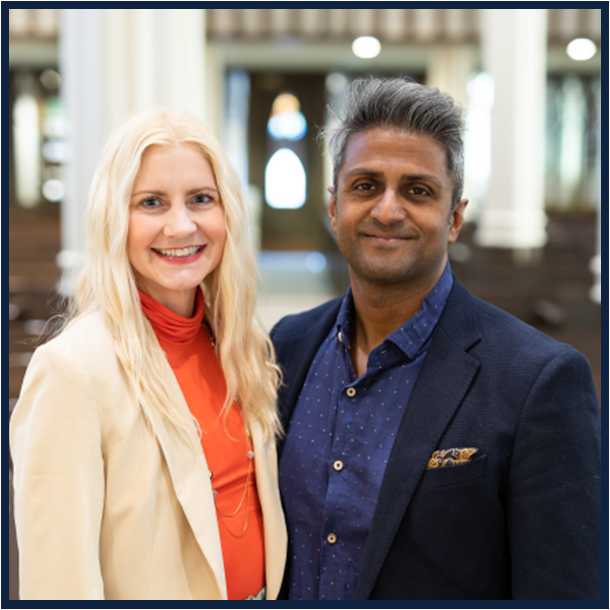
Clarissa Reddi and Vishnu Reddi
Community Space Co-Chairs

Economics: This topic is a paradigm shift for many people. The bottom line is that economic self-sufficiency among parishioners is needed, but cannot be assumed. The more a Catholic parish can do for its own parishioners to support them to either stabilize and/or increase their economic status, the better. It is not a goal to make everyone rich! But it should be a goal to use our Catholic community to support one another with business decisions, purchasing, sales, jobs, networking, etc. This used to occur in the past, and it is something we need to return to. One possibility that is very out-of-the-box but that makes very good sense given the downtown location is the idea of establishing a Catholic Business Incubator. This document will not get into the details of such an initiative, but in summary it would be a process and a space to encourage and support Catholics to start, run, and grow new businesses, and the approach would be a win/win for the entrepreneur and the parish in many ways including: wealth-building, jobs, skill-building, internships, donations, branding, etc. The Economics priority requires special attention and is a key facet to St. Mary’s future.
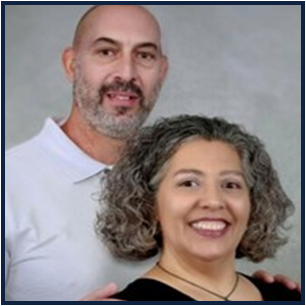
Brad Graham and Cathy Maestas Graham
Economics Co-Chairs

Empowered Parishioner: How many people stated in the survey that they would like a Bible Study, yet none are officially offered by the parish. What does it mean to be “offered by the parish”? What that phrase will come to mean in the future—because parishioners will learn that they are empowered and expected to be proactive stewards of the parish—is that a parishioner will say, “If I want a Bible Study, I will organize one, and I know how to do that because the Governance Council (or whatever it is called) will help me do that.” This approach should be true across the board. There are parishioners willing to step forward and lead, but they don’t know that they can, or that they are being invited to do so. Empowering the parishioners is a key facet to the future of the parish’s ability to realize this Vision.
This Chairperson role is open! Please contact [email protected] if you’re interested.

Volunteerism and Management: Tying in with the notion of the Empowered Parishioner is volunteerism. As more is planned, more people will be needed to help. [Note: The parish will implement its ideas wisely, of course, and not outstrip its parishioner capacity]. As more parishioners understand the opportunity to engage, and are energized by being empowered, there will be a need for a concerted management effort to ensure that the left hand knows what the right hand is doing. In way, this box is highlighting the need for increased volunteerism and the actual increase that will occur, as well as the need to manage volunteers effectively. It is a key facet to the future of the parish as it pursues its Vision.

Care of St. Mary’s Campus: This is the low-hanging fruit of every Catholic parish across the country. If we fix the roof and gutters, or tuck-point the brick, or pave the lot, etc. we’re doing great! Yes, without a well-cared-for church and facilities, you have no parish. But too often the care of bricks and mortar is where the imagination ends. This component, then, is necessary and critical, but it also must not be the only priority—it must be one of many as evidenced by the others listed above. More to the point, this component accounts for the future, as well, and thus is critical both in the present and in the future.
